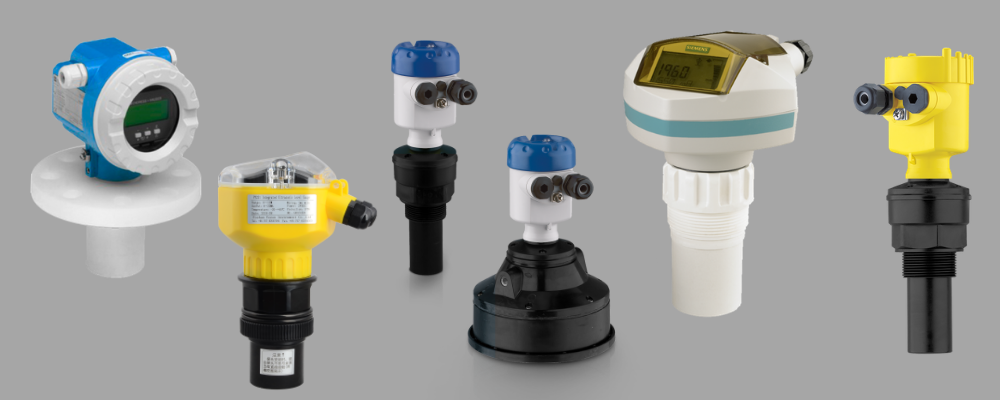No products
Prices are tax excluded
How Does an Ultrasonic Level Sensor Works

There are many ways of non-contact level measurement, each has benefits and limits as well. For example Radar level measurement is great choice for accuracy but very expensive. On the other hand, Ultrasonic level sensors cost less and are easy to install and use, making them the most popular non-contact method for level measurement.
Ultrasonic Level Sensor's Working Principle
Ultrasonic level sensors use the Time-of-Flight measuring principle to measure level. The ultrasonic device sends sound waves at a frequency higher than a humans can hear (from 20 kilohertz to one gigahertz).
These waves bounce back from the surface of the product, creating an echo that goes back to the sender (a sensor). Then, the sensor calculates the time the echo took to return to find out the level. It works in both fluids and solids.
Common Errors in Ultrasonic Level Measurement
This principle seems to be simple. But yet, it is important to keep in mind some technical aspects for getting accurate measurements.
- Temperature of the air can affect sound velocity and interfere with ultrasonic measurements. For example The hotter the air, the sound travels faster. So, an integrated temperature sensor can help you compensate for this effect. There should be uniform temperature between the ultrasonic level sensor and liquid.
- The density of the material you want to measure is very important. It must have a certain density to reflect ultrasonic waves. Sound travels faster through the air than through solids and liquids, so a significant difference in density between the air and your product results in a good signal.
- The ultrasonic level sensor has a blocking distance. This is a distance where it can’t read properly, so you must include that in your calculations.
- The profile of the liquid surface is an important point to consider. If the profile is turbulent, it creates foam and the readings will deflect due to foaming.
- If there are presence of vapor or steam above the measuring surface, it can also affect the measurements of ultrasonic device. This is because vapor and steam can interrupts the transmission and reflect the ultrasonic signal.
- Ultrasonic waves cannot travel through empty space. They need medium like gas, liquid or solid to travel and take measurements. This means vacuum applications are also not possible with an Ultrasonic level transmitter.
If you take these factors into account, you can still use ultrasonic level sensors in many industries and applications. Let’s go over a few of them.
Applications of Ultrasonic Level Sensors in Pakistan
Water and Wastewater Application
The water and wastewater industry most favors ultrasonic level sensors because they help with pump control, cycling and monitoring, overfill protection and more. Now ultrasonic level sensors have become the standard for most liquid level requirements.
Water and Wastewater applications use the concept of open channel flow monitoring technique for measurement of flow in different water systems. In this technique, the flow rate of water is determined by measuring the height of water with the help of an ultrasonic level sensor. Endress + Hauser Ultrasonic Level Sensor (Type: Prosonic-T) is one of the best choice for water and wastewater applications.
Ultrasonic Level Sensor for Chemicals
In the chemical industry, ultrasonic level sensor used in different applications. Such that level measurements for corrosive liquids, rubbers, fuel glues, resins plastics and paints. As the chemical industry often measures potent products, so you’ll need a non-contact level measurement that make ultrasonic level measurement ideal for use.
Ultrasonics level sensors work very good on storage tanks for corrosive materials such as hydrochloric acid (HCl), sulphuric acid (H2SO4), and caustic soda (NaOH).
Keep in mind, you should make sure your sensor material is chemically compatible. Many ultrasonic level transmitters come with wetted materials made of PVDF material.
Ultrasonic Food and Beverage Level Sensor
Ultrasonic level sensors appear in this industry to measure grains, juices, powders, and more bulk solids in silos. But importantly in this industry, the sensors must meet hygienic requirements.
The wetted parts of the level sensor must use certain materials that remain smooth and easy to clean. Otherwise it may ruin the product as well as the readings.
The sensor must meet the clean-in-place (CIP) temperature requirement. A hygienic cleaning cycle reaches up to 120 ˚C, so the sensor must withstand that heat for the length of the cycle.
Sometimes, process can generate dust or noise that interferes with the ultrasonic signal. You can eliminate this issue by choosing a highly sensitive sensor.
Ultrasonic Level Sensor/Transmitter Manufacturing Brands
World most popular brands manufacturing ultrasonic level sensors and transmitters are Endress+Hauser, Siemens, Krohne, VEGA, SICK and list goes on.
In Pakistan Endress + Hauser (E+H) and VEGA are two brands which are most commonly used in the industry.
Ultrasonic Level Transmitter Price in Pakistan
Price depends upon different import factors. You can not say anything with confidence due to fluctuation of dollar in Pakistan. You can check as an example the price of Endress + Hauser Prosonic T level transmitter price at Pakistan Controls and Industrial Automation.
Conclusion
Ultrasonic level sensor makes a good choice for water and wastewater, corrosive liquids and more in non-contact level sensors. Ultrasonic level transmitters are simple and low-cost devices that measure accurate and reliable data without affecting your product.
Also, there are some limitations to ultrasonic level measurement, which can be overcome by opting for radar level measurement.
If you are searching for more products related to industrial automation and instrumentation then please check out our stock here. Where you can find our products related to pressure, temperature, flow and level.
